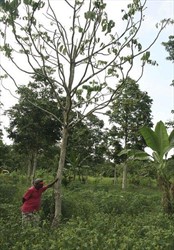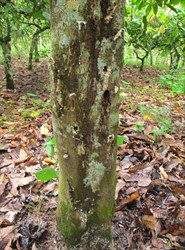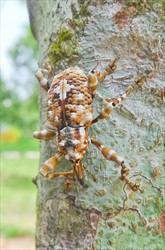- Narrow distribution; reported only from Papua New Guinea mainland and islands. Weevil of the snout family, only recorded on galip (Canarium).
- Major economic importance in smallholder plots and galip plantations (up to 90% trees dead/dying in parts of Gazelle Peninsular). Larvae tunnel into trunks (<10 year-old trees, 80 cm diameter) below first branches, causing canopy loss, dead branches, holes with weeping resin drying white.
- Larvae, creamy-white, brown head, black mandibles; adults, 2-3 cm, long snouts, light brown/white banding on legs, white cross on folded wings.
- Spread: walking, possibly other ways.
- Biosecurity: regulations needed based on better understanding of life history.
- Natural enemies: unknown; yellow crazy and green weaver ants suggested as possibility.
- Cultural control: handpick weevils, use wires to kill larvae in tunnels, avoid stressing trees (i.e., cutting bark or burning trash on trunks). No evidence of resistant varieties.
- Chemical control: test using synthetic pyrethroids poured into tunnels











